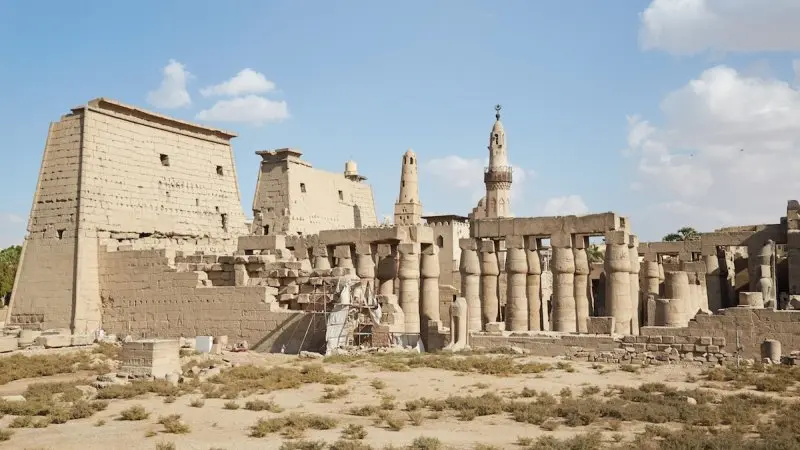Nestled on the east bank of the Nile River in the enchanting city of Luxor, Egypt, stands a testament to the grandeur and magnificence of the ancient world: Luxor Temple. This awe-inspiring structure, steeped in history and architectural brilliance, attracts visitors from across the globe.
With its rich historical significance, remarkable beauty, and cultural allure, Luxor Temple is a must-visit destination for anyone seeking to delve into the mysteries of Egypt’s past.
History
The history of Luxor Temple dates back over 3,000 years, making it one of Egypt’s most significant and well-preserved archaeological sites. Constructed during the New Kingdom period of Ancient Egypt, it served as a place of worship dedicated to the god Amun-Ra, along with his divine wife, Mut, and their son, Khonsu.
Over the centuries, various pharaohs, including Amenhotep III, Tutankhamun, and Ramses II, contributed to its expansion and embellishment.
The temple’s construction spanned several generations, resulting in a fusion of architectural styles, including ancient Egyptian, Greek, and Roman. This blending of influences adds to the unique charm and historical value of Luxor Temple, showcasing the cultural interactions that shaped Egypt’s ancient past.
Why Visit
Luxor Temple offers visitors a truly immersive experience, taking them on a captivating journey through time. Here are some compelling reasons why you should include this extraordinary destination on your travel itinerary:
1. Historical Significance
Luxor Temple played a vital role in religious and political life in ancient Egypt. Exploring its sprawling complex and intricate structures allows visitors to gain insight into the beliefs, rituals, and lives of the ancient Egyptians.
2. Architectural Marvel
The temple’s grandeur and architectural prowess are awe-inspiring. From the imposing pylon gateways to the majestic colonnade hall and the resplendent obelisks, every corner of Luxor Temple showcases the meticulous craftsmanship of its builders.
3. Cultural Exploration
Luxor Temple offers a glimpse into the intermingling of ancient civilizations. As you wander through the temple, you can appreciate the Greek and Roman additions, which signify the enduring influence of these cultures on Egypt’s history.
4. Light and Sound Show
In the evening, Luxor Temple transforms into a magical setting for an enchanting light and sound show. This multimedia spectacle vividly narrates the temple’s history, further enhancing the visitor experience.
Location and Route
Luxor Temple is located in the heart of Luxor city on the east bank of the Nile River. As you arrive in Luxor, you can easily access the temple via taxis, public buses, or by foot, depending on your proximity to the site.
The temple is conveniently situated near other renowned historical attractions, such as the Karnak Temple Complex and the Luxor Museum, allowing you to plan a comprehensive exploration of ancient Egypt’s wonders.
When to Visit
The best time to visit Luxor Temple is during the cooler months, between October and April, when the weather is more pleasant for outdoor exploration. However, if you can withstand the heat, visiting during the shoulder seasons of spring and autumn can be rewarding, as you’ll encounter fewer crowds. It’s advisable to visit early in the morning or late in the afternoon to avoid the peak hours when tour groups arrive.
What to See
As you step into the realm of Luxor Temple, a myriad of captivating sights awaits you:
1. Avenue of Sphinxes
Begin your journey by strolling down the iconic Avenue of Sphinxes. This awe-inspiring processional pathway was lined with hundreds of sphinx statues, symbolizing the god Amun’s protection and divinity.
2. The First Pylon
Marvel at the towering first pylon gateways, adorned with intricate reliefs depicting ancient battles and religious rituals. These monumental gateways guard the entrance to the temple and set the stage for the architectural splendor that lies within.
3. Colonnade Hall
Enter the breathtaking colonnade hall, featuring a forest of towering columns adorned with intricate hieroglyphic inscriptions and vibrant wall reliefs. The hall is a testament to ancient Egyptian engineering prowess and serves as a testament to the grandeur of the New Kingdom.
4. Obelisks
Admire the colossal obelisks that flank the entrance of Luxor Temple. Although one of the obelisks is now located in the Place de la Concorde in Paris, the remaining obelisk stands tall, serving as a reminder of Egypt’s ancient glory.
Conclusion
Luxor Temple stands as a living testament to Egypt’s awe-inspiring past, offering visitors an unparalleled opportunity to explore the ancient world’s magnificence. From its historical significance and architectural marvels to its cultural allure and immersive experiences, Luxor Temple captivates the imagination and leaves an indelible impression on all who visit.
Embark on a journey through time, and let Luxor Temple unravel the mysteries and wonders of ancient Egypt before your eyes.







